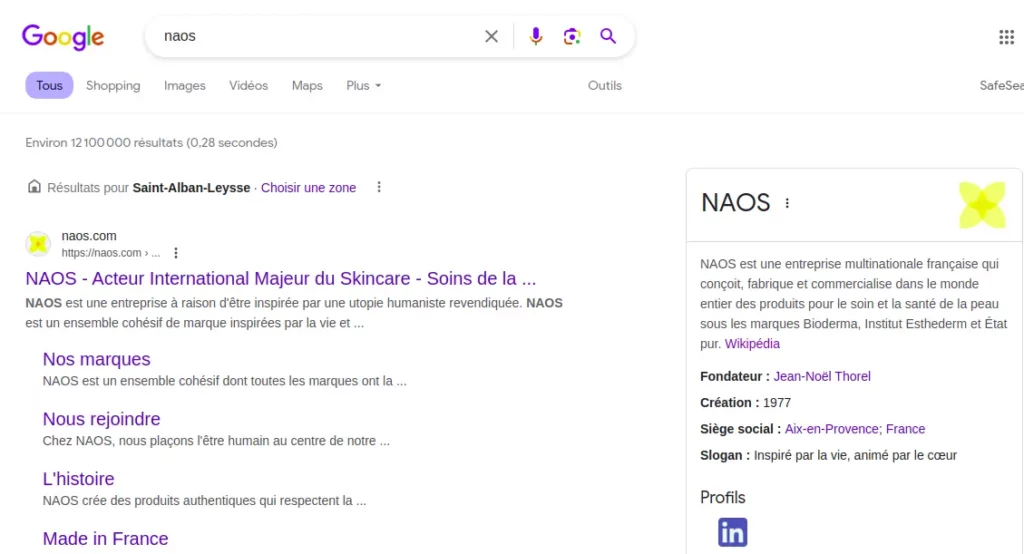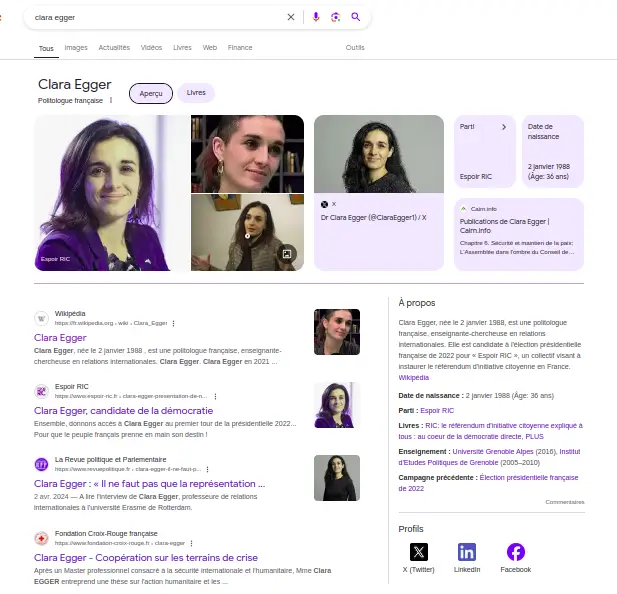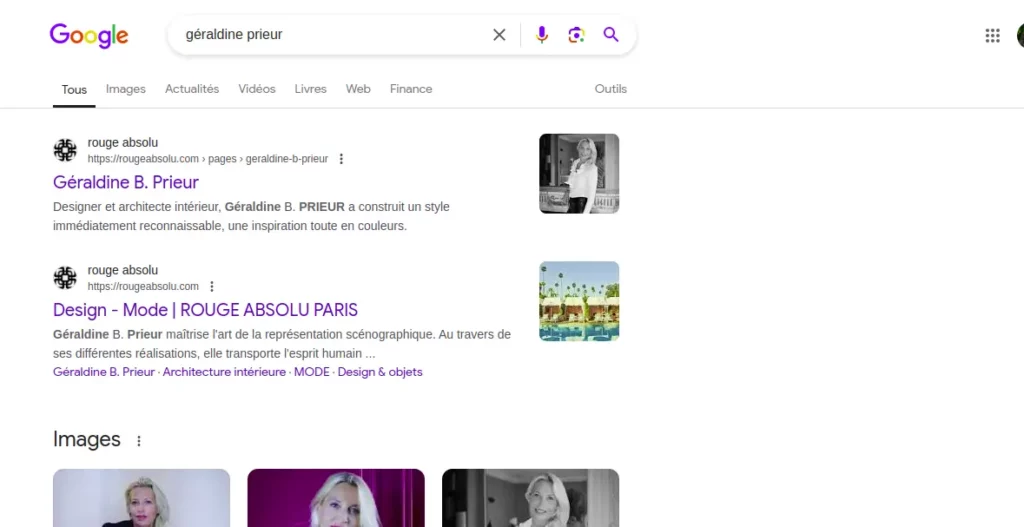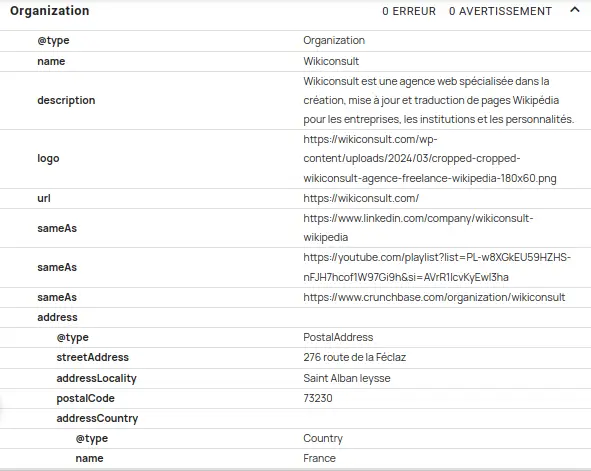In this article, I explain why it’s a good idea to take a minimum interest in your Google Knowledge Panel when you have a presence on the Internet, or want to develop it. And how to create or update it, with or without a Wikipedia page.
Plan
What is the Google Knowledge Panel?
The Google Knowledge Graph is a database used by Google to improve the relevance of search results by providing factual information in a structured format: the Google Knowledge Panel.
You often see this at the very top of Google results when you type in the name of a well-known company or person (or even a book, podcast, etc.):
- right on computer ;
- as first or second result in the google search bar on your phone.
It’s a bit like your digital business card.

Learn more about knowledge graphs for SEO, digital marketing, and AI purposes
Where does the information come from?
Google’s bots crawl the web to collect data on all subjects (known as scraping), then synthesize it. In particular, the data comes from :
- Wikipedia;
- Wikidata ;
- your GoogleMyBusiness ;
- Crunchbase ;
- theorg.com;
- forbes.com ;
- fandom.com;
- your own websites ;
- your social networks (especially your LinkedIn page);
- institutional sites ;
- for certain industries, specialized databases such as IMDb for films, MusicBrainz for music, or Google Scholar for academic publications.
Internet users can also suggest modifications to an existing Knowledge Panel. All the more so for people representing the subject in question.
What’s the point of having one?
Having your own Knowledge Graph (and controlling it at the very least) for your brand, your company or yourself means :
- a guarantee of credibility, notoriety and authority: this means that there’s enough data about you for Google to “bother” to process it;
- better visibility ;
- greater control over your brand image and online reputation, as you can partially influence what is displayed;
- increased opportunities for engagement, since the Graph generally links to all your social networks: the web surfer just has to choose the one that suits him best.
On the other hand, it doesn’t directly improve traffic to your site from Google (SEO). For example, if you have your own Wikipedia page, the Panel is more likely to link to your Wikipedia page, which Google considers more neutral, than to your website.
Here’s a small illustration of the credibility of a Knowledge Graph:


How do I get one?
There are several ways to “force” Google to create your Knowledge Graph, or to modify its content.
Note that it’s not possible to determine with absolute certainty whether these actions will have an impact on the Knowledge Gaph, and when.
By creating a WIkipedia page
If you’re well-known enough to have your own Wikipedia page, then the best way to get your Google Knowledge Panel is to create your own Wikipedia page. You’ll kill two birds with one stone: a Wikipedia page will improve your reputation, authority and natural referencing.
If you already have your own Wikipedia page, you can modify certain elements of its introduction or infobox to potentially influence the Graph. You must, of course, respect Wikipedia’s editing rules!
For the customers we support at Wikiconsult, we observe the following deadlines:
- 2 to 6 weeks from the time we put a new Wikipedia page online to the time the Panel is created – the more notable and long-established the company, the shorter these lead times:
- a few weeks between the moment we modify a Wikipedia article and the moment these modifications appear.
These deadlines seem to have been extended since the last major Google updates in summer 2023 and spring 2024.
Without creating a Wikipedia page
It is possible to influence the display of a Google Knowledge Panel in other ways, with a higher uncertainty of success.
This must be done in a very formalized way to maximize the chances of success:
- identify (or create) the referring web page: for example, for a person, the /apropos page of their personal website (firstname.fr); for a company, the /apropos page of the company website, etc. This page must be structured and optimized so that Google recognizes the important elements you ideally want to appear on your Knowledge Panel;
- identify all social networks and other web pages referring to the entity, such as a Crunchbase profile (or create one), etc. Add a link to the referring web page;
- identify all entity-centric databases such as Wikidata, INSI, DBpedia, etc. and update the data;
- list all the sites where there are reviews of the entity: Trustpilot, Yelp, Angie’s List, TripAdvisor, Capterra, etc., update the data and add a link to the referring web page if possible;
- create a Schema tag (Schema Markup, a structured data code) gathering the most important information. Use the guides provided by Schema.org and validate it with https://validator.schema.org. If you already have a Knowledge Panel, add its ID to the Schema tag;
- add the schema tag to the referenced web page;
- Submit the updated version of the referenced web page to Google Search Console ;
- Be patient: it can take up to 1 year for Google to take all this into account (and sometimes it never does!).
Below is the Schema tag I created for my agency Wikiconsult – I hope to have a Google Knowledge Panel for Wikiconsult by early 2025!

I hope you’ve found my article useful! If you have any questions, or need personalized assistance in creating your Knowledge Graph (with or without a Wikipedia page), please contact me.
Delegate the creation of your Wikipedia page
This is a service we offer after a reputation audit.


Written by Albin Guillaud
A Wikipedia contributor since 2014, with Wikiconsult I support businesses, institutions, public figures, and agencies looking to create, update, or monitor their presence on Wikipedia.